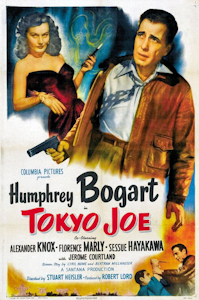

| Tokyo Joe | |
|---|---|

1949 film poster
| |
| Directed by | Stuart Heisler |
| Written by | Walter Doniger (adaptation) |
| Screenplay by | Cyril Hume Bertram Millhauser |
| Based on | Steve Fisher (from a story by) |
| Produced by | Robert Lord |
| Starring | Humphrey Bogart |
| Cinematography | Charles Lawton Jr. |
| Edited by | Viola Lawrence |
| Music by | George Antheil |
| Color process | Black and white |
Production | |
| Distributed by | Columbia Pictures |
Release date |
|
Running time | 89 minutes |
| Country | United States |
| Language | English |
| Box office | $1.9 million[1] |
Tokyo Joe is a 1949 American film noir crime film directed by Stuart Heisler and starring Humphrey Bogart. This was Heisler's first of two features starring Bogart, the other was Chain Lightning that also wrapped in 1949 but was held up in release until 1950.
After spending World War II in the Air Force, ex-Colonel Joe Barrett returns to Tokyo to see if there is anything left of his pre-war bar and gambling joint, Tokyo Joe's. Amazingly, it is more or less intact and being run by his old friend Ito. Joe is shocked to learn from Ito that his wife Trina, whom he thought had died in the war, is still alive. She has divorced Joe and is married to Mark Landis, a lawyer working in the American occupation of Japan. She has a seven-year-old child named Anya.
To stay in Japan after his visitor's permit expires in 60 days, Joe wants to set up an airline freight franchise, but he needs financial backing. Through Ito, Joe meets Baron Kimura, former head of the Japanese secret police. Kimura offers to finance a small airline business that will carry frozen frogs for export to North and South America, even though Joe believes Kimura is going to use the airline as a front, carrying penicillin, saccharine, and pearls. But as the army hesitates in giving Joe permission to open the business, Kimura shows him proof from the Japanese secret police files that Trina worked broadcasting propaganda for the Japanese, a treasonable offense since she was a naturalized American citizen married to an American citizen. When Joe confronts Trina with this evidence, she explains that she made the broadcasts only to protect her newborn baby whom the Japanese took away from her when she was in Oyama prison camp. She reveals that she was pregnant when Joe deserted her, and that Anya is his daughter. Joe wants to back out of the airline deal, but Kimura demands that he go through with it. To save Trina, Joe accepts Kimura's proposal and convinces Mark Landis to help him start the airline business before his visitor's permit expires.
Joe then discovers through American occupation authorities that Kimura actually intends to smuggle in fugitive war criminals (former senior officers of the Imperial Japanese Army and the leader of the Black Dragon Society) to start a secret anti-American movement. The authorities plan to apprehend them when they land at Haneda Airfield. But Kimura finds out that Joe had met with the Americans, and before Joe flies to Korea, Kimura informs him that Anya has been kidnapped and will be freed only when the Japanese are delivered at a certain deadline. Joe picks up his passengers and is about to land them at the Army-designated airfield when the Japanese hijack the plane with guns and land at a different airstrip in Okuma. The US Army intercepts the Japanese before they can be driven away, as they had every airstrip on Honshu covered.
Back at the bar, Joe finds out from mortally wounded Ito that Anya is being held in a basement at the old hotel next door. Joe enters the dark cavern and finds Anya, but he is shot by Kimura as he carries Anya to safety. Arriving American soldiers kill Kimura. Joe, seriously wounded, is carried out on a stretcher.
From The Films of Humphrey Bogart:[2]
Uncredited:

The film was Sessue Hayakawa's first postwar project and served as a revitalization of his career. From 1937 to 1949, Hayakawa had been in France, first as an actor and then was caught up in the German occupation, living ostensibly as an artist, selling watercolors. After joining the French Resistance, he aided Allied flyers during the war. When Humphrey Bogart's production company tracked him down to offer him a role in Tokyo Joe, the American Consulate investigated Hayakawa's activities during the war before issuing a work permit.[3]
Principal filming for Tokyo Joe took place from January 4 to the end of February 1949 on the Columbia Pictures studio lot, not on location in Tokyo, Japan. A second photographic unit was dispatched by Columbia to Tokyo to collect exterior scene shots and was the first movie company allowed to film in postwar Japan. The use of a Lockheed Hudson bomber converted into cargo hauling is featured with both interiors, and aerial sequences revolving around the aircraft.
The film fared well with the public as the subject of postwar Japan was an intriguing one featured in many of the headlines of the day. Most viewers were convinced that the film was a semi-documentary due to the extensive use of footage shot in Japan. The critics were less charitable, The New York Times contemporary review noted the juxtaposition of the footage as jarring: "a note of reality which is embarrassingly at odds with the major and markedly synthetic elements of the plot", further stating: "The big weakness of Tokyo Joe, however, is a script which does not neatly come together, but squanders its good points amidst a field of corn."[4]
Tokyo Joe was released in VHS format for home viewing on August 17, 1989, by Columbia TriStar with a further DVD release in 2004.[5]
|
Films directed by Stuart Heisler
| |
|---|---|
|